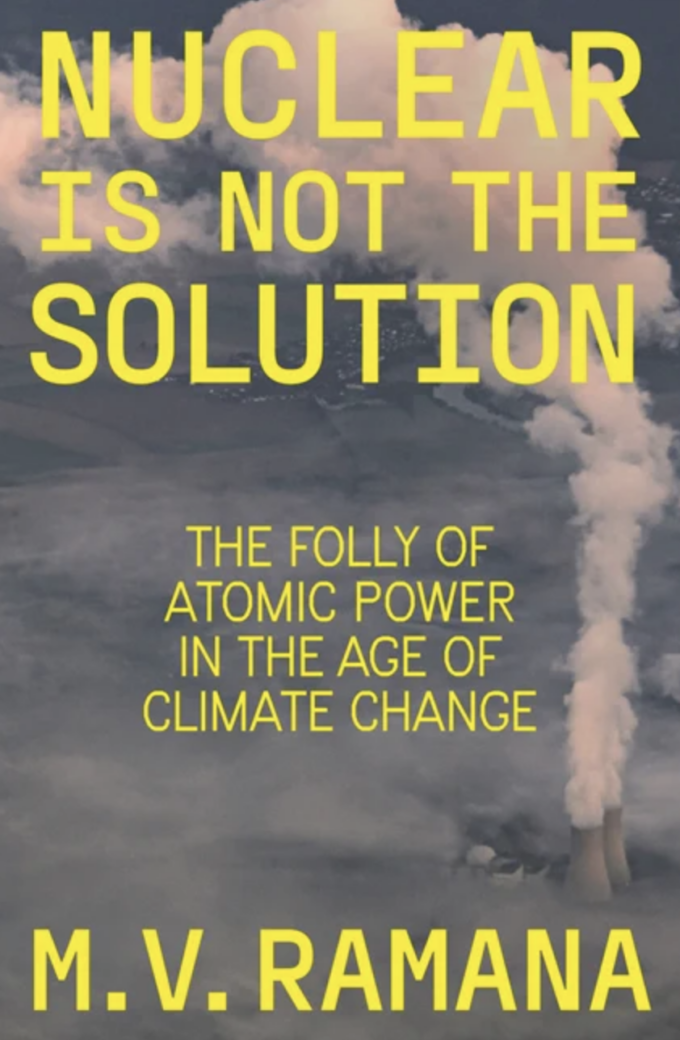
Image by Nicolas Hippert.
This past June, a couple of my sisters and I drove from California to Minnesota. One of the states we traveled through was Idaho. We gassed up in a town called Atomic City, which advertised itself as the first city in the United States to have nuclear-powered electricity. This town is inside what grounds of the Idaho National Laboratory, an 890 square mile research site run by the Department of Energy together with various commercial and military interests. Its website currently touts its scientific expertise and its mission devoted to carbon-free nuclear energy, alternative energy and military security. There are currently over 6000 employees working at the various sites of the laboratory, which includes over fifty nuclear reactors and has an annual budget of $1.6 billion dollars. The laboratory and its web page provide a perfect example of how the business of nuclear energy as described by author M. V. Ramana in his brilliant new book Nuclear is Not the Solution: The Folly of Atomic Power in the Age of Climate Change actually works.
Indeed, the laboratory’s work is a physical and very real representation of the triple threat Ramana describes in the text: the development of nuclear energy, nuclear weapons, and, almost as an afterthought, alternative energy sources like solar and wind. Ramana, who holds the Simons Chair in Disarmament, Global and Human Security and is a Professor at the School of Public Policy and Global Affairs at the University of British Columbia in Vancouver, Canada, is a longtime opponent of the nuclear power industry and the government that collaborate and support it. His scientific background provides a solid rebuke to those in the industry and those who shill for it who repeat the same half-truths and lies whenever nuclear energy is brought up. In addition, this book is a convincing response supported by solid science (and a bit of political economy) to those who want the public to believe that nuclear power is a reasonable and affordable alternative to fossil fuels and the global climate crisis.
Chapter by chapter, Ramana addresses the health risks, the economics of, and the unbreakable link between nuclear power and the nuclear war industry. Instead of talking in terms of possibility, he focuses on the existing circumstances. To those who would try and sell the public a new nuclear plant by suggesting that the possibility of a nuclear accident at the plant is infinitesimal, Ramana writes:
“Theoretical predictions of stupefyingly low accident probabilities do not square with the empirical evidence of severe accidents at nuclear reactors.”(26)
In other words, believe what you see, not what the industry says. In another chapter, Ramana questions the method by which the private power utilities socialize the costs while privatizing the profits. Perhaps the most shocking aspect of this phenomenon is the contracts and laws that force utility companies to pay for plants that never go online (and, in some cases, are never even built.) I recall this occurring when I lived in North Carolina. South Carolina Electric & Gas Company (SCE&G) lobbied for and received the go-ahead to build two nuclear reactors. As costs mounted, the company asked the Public Utilities Commission to allow the firm to charge customers for the costs associated with building the plants. To make a long story short, customers are still paying for the plants, and the plants were never built. Ramana provides a detailed account of this story in a chapter he titles “Private Profits, Social Costs: Industry Strategies” as a perfect example of how the industry works.
In his chapter on the links between nuclear power and the nuclear war industry, the author is equally scathing. When discussing the claim made by some environmentalists who support nuclear power that the nuclear power industry and the nuclear war industry are two different things, Ramana is clear: any separation is simply an illusion. In fact, he argues that one reason governments are so willing to support the nuclear power industry is because it produces the essential element plutonium for nuclear weapons as a supposed by-product. In fact, it appears more likely that plutonium is not a mere by-product but one of the primary reasons for the ongoing governmental support for the industry.
Nuclear is Not the Solution discusses the nuclear industry in a frank and honest manner. There are no questionable claims about nuclear energy or fantastic excuses made for the industry’s mistakes and its questionable premises. The text details the industry’s lies, mistakes and cover-ups, reminding the reader that they should focus on the historical and empirical facts, not fanciful advertising and promises. He describes an industry rife with corruption and hungry for profits. Although his primary focus is on the industry in the United States, Ramana does not spare other nuclear powers from his reasoned and well-informed exposé. Those who think nuclear energy should be the future would do well to read his book. It should convince one the opposite is more likely the truth.
No comments:
Post a Comment